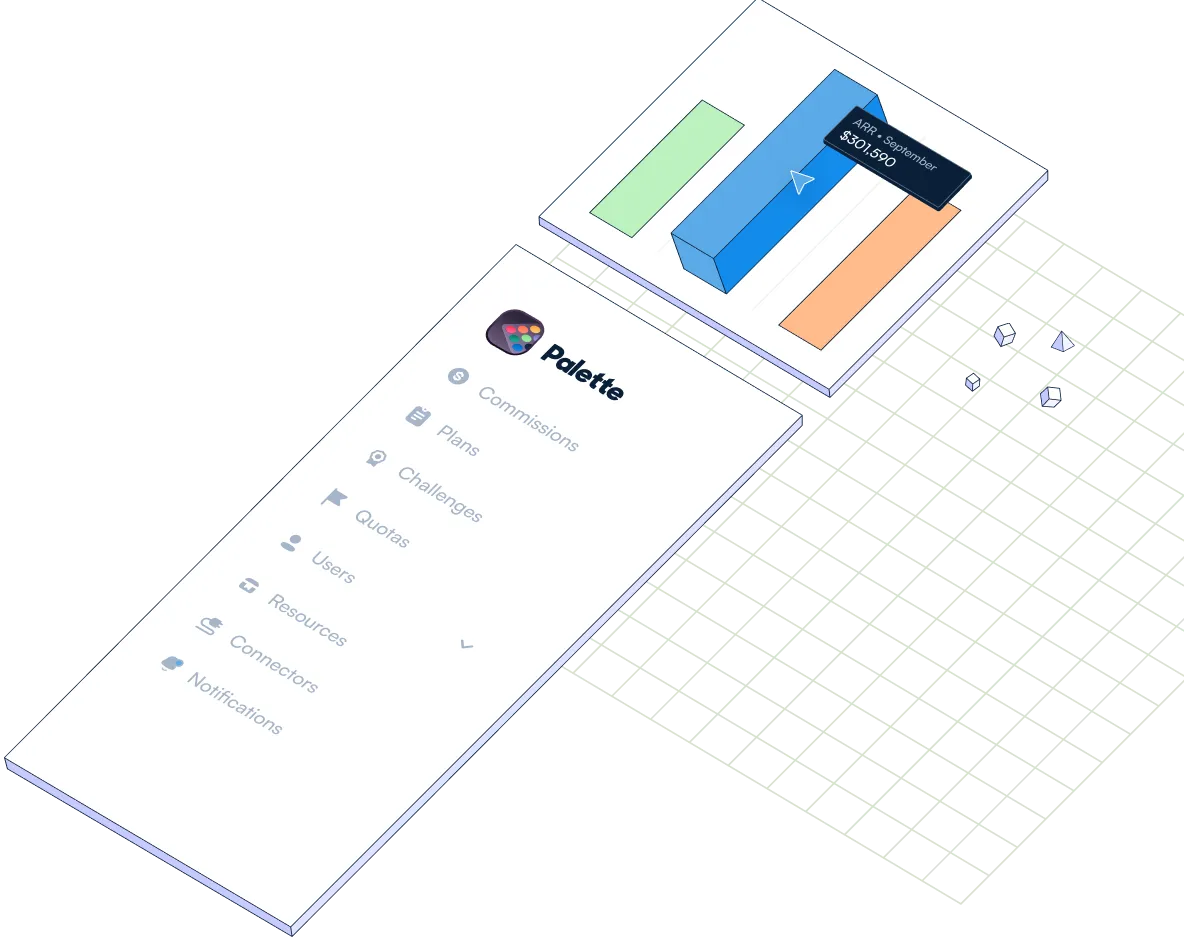Sales Compensation Plan
Sales managers must create a competitive and manageable sale compensation plan to entice new talent and keep their loyal team members. Within the sales team, sales compensation and commission are crucial to how successful your team and company will be. You do not want to give the best employees a reason to decline a position and re-think investing in a long-term future with your company. It is typically a basic salary, commission, and extra incentives to motivate a high-performing team.
A sales compensation plan typically contains a tiered plan which shapes the salary of a sales representative, depending on their performance. It sets the standards and expectations within your company and should drive people to hit monetary and professional goals. It also helps companies budget any finances better with a set plan.
Within a commission structure template, the following will be included:
Basic salary is the minimum amount of money an employee will have every payday.
Predicted sales are the number of sales a sales rep is expected to hit.
Commission is the rate, usually a percentage, of the profits or sales the employee brought in a specified time.
Bonus: This is money added to employees' wages to show they have been productive in a specified period.
Commission per sale: This is the amount paid to the sales rep depending on their sales in a specified period.
While there is no specific way to pay your sales employees, sales compensation plans detail how an employee can simultaneously increase their salary and productivity. These plans can be very detailed or basic depending on an employee's experience level and a company's budget.
Here is a basic sales incentive plan example:
|Basic Salary|$50,000|
|Projected Salary|$1,000,000|
|Commission Starts At|$20,000|
|Commission Caps At|$500,000|
|Commission Percentage|20%|
|Commission Earned|$96,000|
|Total Compensation|$146,000|
Sales Commission Structure
When creating the structure of your sales commission plan, you first need to acknowledge your overall business goals. The best plans are the ones that incorporate the objectives of your business. These compensation plans may increase or decrease as the company fluctuates, but working with top management on these plans will ensure they align with the company's strategic goals.
The sales compensation structure can be designed once you identify the roles within the sales team. You may decide to compensate each employee based on seniority or longevity with the company.
Typical sales compensation plan structures contain these attributes:
Target pay: This includes everything that a business provides an employee. It will consist of salary, commission, bonuses, and additional incentives.
Pay ratio: This is the ratio in which the base salary and incentives are paid to an employee. This could be 50:50, where 50% of a sales rep's salary is from a fixed salary and 50% is from sales incentives.
Upside potential: This is the monetary value given to employees that exceed their sales quotas.
Sales manager compensation structure will be similar to this, typically with a more significant percentage of their salary going towards sales incentives. When designing your compensation plan, be open with your employees about your sales strategy. Rewarding all members of your sales team, including supporting roles, will keep team morale and productivity high.
Using a sale compensation planner will make designing and calculating numerous sales commission plans quicker and more efficient.
Types of Sales Compensation Plans
There are various ways that sales managers can incentivize their employees using their sales commission plans. The sales compensation calculator with Palette HQ can create a customized sales compensation plan for every employee. They can be very specific or vague, depending on the employee. There are several types of sales compensation plan structures, including:
Basic Salary and Commission Plan
This is the most common sales compensation structure, and it provides a basic salary along with a predetermined commission rate. This gives the employee a lot of security. They will have a minimum income along with a massive incentive to perform at their best.
Basic Salary Plus Bonus and Compensation Plan
This plan includes a fixed base salary and a specified commission rate with no minimum or maximum commission caps. This is a good plan for employees that consistently hit their targets.
Commission-Based Compensation Plan
This type of salary involves no basic pay as the employee is just paid a commission solely on their performance and how many sales they have made in a specified time.
Profit-Based Commission Plan
This is the most common sales manager commission structure as it is based on increasing profits rather than individual sales. So if the sales rep sells more expensive products or a larger volume of cheaper products, they will gain more compensation.
Target-Based Commission Plan
This plan allows sales reps to collect their commission when they reach a specific target. For example, if they bring in a new customer, they will receive a bonus.
Straight-Line Commission Plan
This sales compensation plan will only reward employees depending on how much or little they sell. For example, if they sell 30% of their monthly quota, they will receive that compensation.
Sales Incentive Plan Design
When completing a sales incentive plan design, there are some of the best practices to consider:
- What compensation plan will be used for each employee, depending on seniority? Most employees will receive the normal sales commission of 20-30%, but is there any employee that has performed exceptionally that many require more?
- Ensure that the compensation plans effectively boost productivity and keep your employees satisfied.
- Using a software platform like Palette to automate sales compensation plans and payments. It can integrate all sales data into your HR payroll to make salary payments more manageable.
- Ensure the sales compensation formulas are correct for each individual.
- Ensure your sales compensation plan aligns with the company's sales targets and annual profit margins.
- Review and approve sales compensation plans once reviewed by shareholders and the CEO.
- Develop a reasonable timeline for all these programs, communication, and incentives.
- Consider the legal issues surrounding compensation, whether it is money-based or stock-based, and whether it is legal in the country the business operates.
Considering these factors before and during the planning of a sales incentive plan, the final result should be comprehensive and fair to any employee within the sales team.
Sales Compensation Governance
Sales compensation governance provides the guidelines and tools that enable top management to maintain the integrity of the compensation plans. It involves monitoring the sales manager and employee compensation plans to ensure they meet company and individual employee objectives. Any misalignment should be caught as early as possible to avoid adverse outcomes such as disgruntled employees, over budget and affecting profit margins, and any misleading or illegal activity.
Also, along with the sales compensation plans, sales policies should be monitored to ensure that compensation plans are always aligned with the company's objectives. In many companies, setting sales compensations can be ruthless and a little lawless. By putting it into a definite plan and establishing a pay scale, it will adhere to any guidance given by top management and stay within the budget of the sales team.
Using a tool like Palette, you can easily track sales performance while being transparent and trustworthy. This software platform will align your compensation plans with the company plans by creating commission rules and criteria. It can be efficiently designed so no critical information is missing.
Sales Compensation Analysis
It is best practice to complete a sales compensation analysis every quarter, including all executive and top management. It is easy only to review these plans every year or during an employee performance review, but completing this review every quarter gives your HR team plenty of time to make any adjustments.
Many potential factors and issues could impact employees' salaries and commissions, and by reviewing these plans every quarter, every issue will be dealt with in real time so there are no underlying problems.
During the review, it is good practice to complete sales compensation benchmarking to determine the average pay practices with your competitors to ensure your company can attract top sales talent and optimize your sales performance.
When analyzing sales commission plans, looking at a range of figures for many employees can be daunting. To make this analysis more manageable, there are several tools you could use, including the tiered commission calculator that lets you commission amounts in cumulative tiers. It does the hard work, so you do not have to.
Commission Plan Examples
Numerous types of sales commission and bonus examples can be utilized for sales employees. Companies have a range of ways to incentivize their customers; this includes sales bonus plan examples.
If you want to streamline your commission planning, using a software platform like Palette will elevate your planning and reduce how long you need to construct and design commission and compensation plans for all your employees.
You can monitor the performance of each of your employees over a specified time and then export this information into your payroll software. It makes organizing and monitoring all sales and salary expectations easier and more efficient.
Why Palette?
Automate calculations
Automate sales commission payments. Create commission rules, define a payout schedule and access monthly statements for each sales rep.
Motivate and coach with real time dashboards
Motivate sales professionals with real-time visibility into commissions. Coach your team, align everybody with company goals and drive long term sales performance.
Compare, simulate and design commission plans
Roll out new commission plans with ease. Compare plans and simulate new rules with a single click.
No more errors
Palette keeps history logs and tracks every calculation detail, helping you to reduce sales commission errors.
Reconcile revenue with CRM data
With Palette you can reconcile invoices and payments with CRM data and pay commissions to your reps only when the money is in the bank.
Create challenges with one click
Incentivize your teams on short term goals. Create a challenge targeting any KPI you want to uplift, drive better results and boost your company’s culture.

Loved by teams and companies you know

















Ready to try
Palette?
